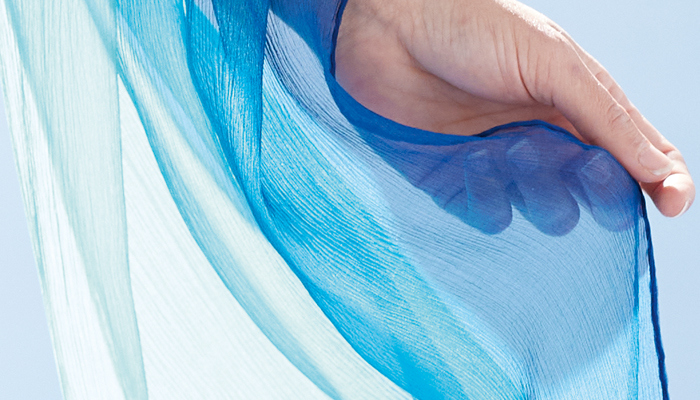How to Fix Colours and Stop Fabrics from Fading
Even the most treasured Cotton top, Linen shirt or Silk dresses can gradually lose their vibrancy over time. Fortunately, there are practical and effective ways to prevent natural fabrics from fading, protect colours, ensuring your favourite garments continue to look fresh and radiant. Before attempting any remedies, it is important to understand how different fabrics respond to washing, sunlight exposure, and everyday wear. Each material reacts in its own way, and having a clear understanding of these differences will help you maintain clothing that stays bright and appealing for years to come.
Know your Fabrics: the First Step to Prevent Fading
Before applying any colour-preserving methods, it is crucial to identify the type of fabric to prevent clothing from fading. Every material has its own characteristics and requires specific care. Fabrics do not all react the same way to fading. Natural fibres, such as Silk, Cotton, Bamboo, Wool and Linen, generally retain their colour longer than synthetic options like nylon and polyester because the dyes penetrate more deeply into the fibres. Selecting high-quality natural fabrics from the outset is a fundamental step to ensure your garments retain their richness and vibrancy for as long as possible.
Avoid Over-Washing
Frequent washing can accelerate wear and cause colours to dull, especially for delicate fibres such as Wool and Silk. Often, spot cleaning and allowing items to air between wears are sufficient to maintain hygiene and freshness.
To prevent natural fabrics from fading and reduce the risk of colour transfer, it is advisable to separate not only white garments from coloured ones, but also highly saturated bright shades from darker tones.
- Cotton – It’s straightforward to maintain, yet it is prone to shrinking if exposed to hot water. Washing in cold or warm water and air drying helps preserve both shape and colour. When ironing is necessary, use a medium heat setting with steam to remove creases effectively.
- Linen – It’s lightweight, breathable, and comfortable, but wrinkles easily. Cold-water washing and flat drying preserve its softness while preventing stiffness. For those who enjoy the crisp Linen look, lightly steaming damp fabric produces excellent results.
- Wool (Merino & Alpaca) – It’s warm, naturally moisture-wicking, and odour-resistant. However, it can shrink quickly if not handled with care. Always opt for hand washing or the Wool programme on your washing machine using cold water. Reshape the garment and lay it flat on a towel to dry, maintaining its structure.
- Silk – It’s a delicate and luxurious fabric requiring gentle treatment. Some items can be hand-washed, while others must be dry-cleaned. When washing at home, choose a mild detergent and avoid wringing the fabric – instead, press it lightly between towels. Always air-dry away from direct sunlight to protect the fibres and maintain colour.
- Bamboo and Tencel – They are eco-friendly, soft, and highly breathable natural fabrics. Wash in cold water with a mild detergent and hang to dry naturally. Avoid using high heat, which can weaken the fibres over time.
Easy Guide to Keeping Colours from Fading
We have compiled a detailed guide on how to prevent natural fabrics from fading, restore and maintain the vibrant colours of your favourite garments over time, using cost-effective and easily accessible methods.
During the Wash Cycle
- Wash in cold water: Hot water can cause dyes to bleed and colours to fade more rapidly. Cold water is gentler on the fibres and helps preserve the garment’s original shade. Always select the lowest possible temperature (maximum 30°C) to protect colours while also reducing energy consumption.
- Turn garments inside out: This shields the outer surface from friction during the wash, helping maintain a fresh appearance.
- Avoid overloading the machine: Crowding the washing machine reduces water circulation and prevents detergent from rinsing properly. Residual detergent can accumulate on garments, increasing the likelihood of fading. Follow the recommended load size for best results.
- Use a gentle cycle: A delicate programme limits agitation, minimising friction and helping retain colour.
- Hand wash if unsure: For fabrics that may not withstand machine washing, fill a basin with cold water and a mild detergent, gently moving the garment without scrubbing. Let it soak for a few minutes before rinsing.
- Select an appropriate detergent: Use mild, liquid detergents designed for dark or coloured fabrics. Avoid harsh chemicals, powdered detergents, or bleach, which can strip dyes and damage fibres.
- Remove stains with care: Blot stains gently with a cloth soaked in water and detergent before placing garments in the wash.
- Use a small amount of fabric conditioner: This reduces friction between fibres and lowers wear and tear, though it may slightly decrease absorbency and breathability.
- Add vinegar or salt: Incorporating a small amount of white vinegar or sea salt into the wash can help set dyes and prevent fading. Baking soda can also be effective. For new garments, pre-soak in cold water with ½ cup of white vinegar and a few teaspoons of salt before the first wash.
After the Wash Cycle
- Air-dry in the shade: Direct sunlight can be harsh on fabrics, causing fading over time. Dry clothes away from direct UV exposure to maintain colour.
- Minimise dryer use: High heat accelerates fading. If using a tumble dryer, select a low setting and remove items while slightly damp.
- Steam rather than iron: A handheld steamer is gentler than an iron, particularly for Silk and Linen. If ironing is necessary, use a cool setting and iron on the reverse side to protect fibres and colour.
Store Clothes the Right Way
Always ensure garments are clean and completely dry before storing. Dirty or damp clothing can develop odours and attract pests. Storage conditions, including humidity, light, and pollutants, can affect colour retention. Keep garments away from direct sunlight and consider breathable Cotton bags or muslin wraps for optimal airflow.
- Wool and knits: Fold and store in a cool, dry space, using lavender sachets to deter moths.
- Linen and Cotton: Hang to prevent deep creases and allow ventilation.
- Silk: Use a breathable garment bag to avoid snags and fading.
Sustainable Washing Practices to Extend the Life of Your Clothes
Caring correctly for natural fibres not only prolongs the life of your wardrobe but also supports environmentally friendly fashion practices.
- Wash less frequently: Not every item needs laundering after a single wear.
- Use a Guppyfriend bag for delicate fabrics: Protects garments while reducing microplastic pollution.
- Line dry whenever possible: High temperatures break down dyes. Air drying preserves colour, prevents heat damage, and saves energy.
By following these simple yet effective tips, you can ensure your favourite garments stay vibrant and fresh for years to come. Understanding the fabrics you wear, washing and storing them carefully, and using a few affordable remedies can make a huge difference in preventing fading. With just a little attention and care, it’s easy to enjoy clothing that looks as good as new, while also supporting more sustainable and responsible fashion habits.



